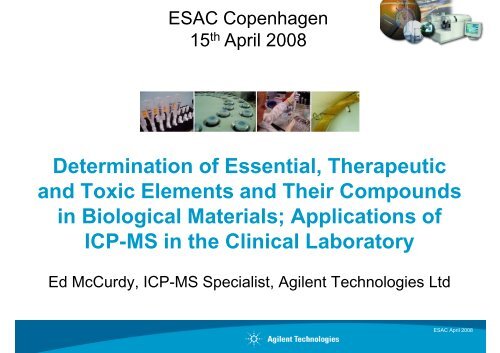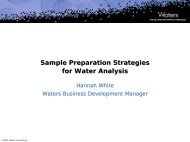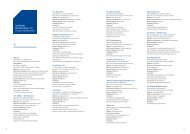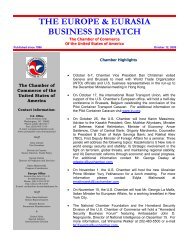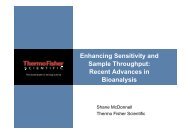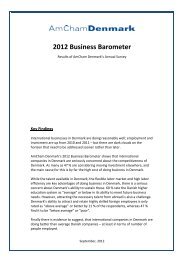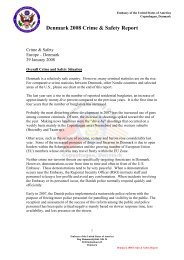Create successful ePaper yourself
Turn your PDF publications into a flip-book with our unique Google optimized e-Paper software.
ESAC Copenhagen<br />
15th 15 April 2008<br />
th April 2008<br />
Determination of Essential, Therapeutic<br />
and Toxic Elements and Their Compounds<br />
in Biological Materials; Applications of<br />
<strong>ICP</strong> <strong>ICP</strong>-<strong>MS</strong> <strong>MS</strong> iin th the Cli Clinical i l Laboratory<br />
L b t<br />
Ed McCurdy, <strong>ICP</strong>-<strong>MS</strong> Specialist, Agilent Technologies Ltd<br />
ESAC April 2008
Scope<br />
Introduction to <strong>ICP</strong>-<strong>MS</strong> for clinical sample analysis<br />
• Requirement for elemental analysis in clinical samples<br />
• Routine trace element monitoring<br />
• Analysis of f toxic and harmful f elements<br />
– Elemental screening, poisoning, radionuclides<br />
– TToxic i organometallic t lli compounds d<br />
<strong>ICP</strong>-<strong>MS</strong> analysis for the measurement of organic compounds<br />
• Identification and quantification of pesticide residues<br />
• Quantification of Chemical Warfare Agent degradation products<br />
FForensic i Applications A li ti of f <strong>ICP</strong> <strong>ICP</strong>-<strong>MS</strong> <strong>MS</strong><br />
• Laser Ablation <strong>ICP</strong>-<strong>MS</strong><br />
• Direct Analysis of Elemental Distribution in Tissues<br />
Page 2<br />
ESAC April 2008
What is <strong>ICP</strong>-<strong>MS</strong>?<br />
An inorganic (elemental) analysis technique<br />
<strong>ICP</strong> - Inductively Coupled Plasma<br />
<strong>MS</strong> - Mass Spectrometer<br />
• high temperature electrical discharge,<br />
which c decomposes, deco poses, ato atomizes es aand d ionizes o es<br />
samples<br />
– forms ions, so compounds not measured<br />
directly<br />
Page 3<br />
• quadrupole (“quad”) mass analyzer<br />
• mass range from 5 to 260 amu (Li to<br />
U...)<br />
– separates all elements in rapid<br />
sequential scan<br />
– isotopic information available<br />
• ions measured using dual mode<br />
detector<br />
– ppt level LODs for most elements<br />
– Calibration range up to 1000 1000’s s ppm<br />
• Spectral interferences removed<br />
using collision/reaction cell<br />
ESAC April 2008
Agilent 7500cx <strong>ICP</strong>-<strong>MS</strong> System with<br />
Collision/Reaction Cell (CRC)<br />
Reaction Gas Inlet<br />
High<br />
temperature<br />
27MHz plasma<br />
generator<br />
Page 4<br />
Plasma<br />
Low flow sample<br />
introduction system<br />
Multi-element interference removal by<br />
on-axis octopole reaction cell<br />
Off-axis<br />
LLens<br />
Octopole<br />
Fast simultaneous dual<br />
mode detector (9 orders<br />
dynamic range)<br />
High frequency<br />
hyperbolic quadrupole<br />
ESAC April 2008
Elements of Interest in Easily Extractable<br />
Fluids (Urine, (Urine Blood Blood, Serum Serum, Plasma)<br />
Highly toxic heavy metals<br />
• As, Cd, Pb and Hg<br />
Potentially toxic elements<br />
• Al, Sb, Ba, Be, Bi, Li, Ni, Sr and Tl<br />
Essential elements<br />
• CCr, CCo, CCu, MMg. MMn, SSe, V and d ZZn<br />
Page 5<br />
Wid Wide range of f elements l t may be b measured, d including i l di<br />
many, such as Be, As, Se, Hg, U, which are considered<br />
“difficult” by y other techniques q<br />
ESAC April 2008
Which Elements can be Measured Using<br />
<strong>ICP</strong> <strong>ICP</strong>-<strong>MS</strong>? <strong>MS</strong>?<br />
Page 6<br />
All elements in colour can be measured<br />
– only those elements present in the<br />
plasma gas, 260amu, and<br />
those which are not ionized, are<br />
inaccessible<br />
ESAC April 2008
Analytical Needs for Inorganic Measurements<br />
in Clinical Laboratories<br />
The technique must possess robust sample introduction<br />
• To handle large sample numbers and differing matrices routinely monitored<br />
Measurement of many elements in the same fast acquisition<br />
• Removal of interferences<br />
• Screening applications<br />
Quadrupole <strong>ICP</strong> <strong>ICP</strong>-<strong>MS</strong> <strong>MS</strong> can<br />
• Sample turnaround/productivity meet all of these criteria<br />
• Reduced cost of analysis<br />
Make measurements at trace levels (low detection limits) and at high<br />
concentrations in the same acquisition q<br />
• To reduce reruns, improve productivity and lower costs<br />
The ability to measure element species is also provided by <strong>ICP</strong>-<strong>MS</strong> <strong>ICP</strong> <strong>MS</strong><br />
• Expands range of applications, and provides useful background research info<br />
Page 7<br />
ESAC April 2008
Collision/Reaction Cell to Remove<br />
MMatrix-Based t i B d SSpectral t l Interferences<br />
I t f<br />
(ppb)<br />
Apparent A Cr552<br />
Concentrattion<br />
in Blank<br />
20<br />
15<br />
10<br />
5<br />
0<br />
Page 8<br />
Cr52<br />
ClO/ClOH<br />
(mass 52)<br />
overlap in<br />
HCl matrix t i<br />
AC( ArC (mass<br />
52) overlap<br />
in acetic acid<br />
matrix<br />
ArC and ClO<br />
overlaps in<br />
combined<br />
matrix<br />
01% 0.1% 5% 5% HCl 1% 1% 200 200ppm 200 200ppm 500 500ppm Mi Mixed d<br />
HNO3 HNO3 H2SO4 AcOH Na Ca P Matrix<br />
Matrix Blank<br />
Ad Advantage t of f Collision/ C lli i /<br />
Reaction Cell <strong>ICP</strong>-<strong>MS</strong><br />
• Provides removal of<br />
spectral overlaps –<br />
allows accurate trace<br />
element analysis in<br />
variable high-matrix high matrix<br />
H2 samples<br />
He • Example shows the<br />
NoGas removal of ClO ClO, ArC<br />
interferences in various<br />
matrix blanks<br />
• He collision mode gives<br />
reliable removal of all<br />
polyatomic interferences<br />
regardless of the sample<br />
matrix composition<br />
ESAC April 2008
Routine Analysis of Urine – Sample<br />
Preparation and Calibration<br />
Di Direct t analysis l i of f urine i samples l following f ll i a 1/5 or 1/10 ( (v/v) / )<br />
dilution with deionized water and nitric acid<br />
• No clogging of the nebulizer<br />
• No particle deposition in the injector tube over 12 hours of analyses<br />
Calibration using Method of Standard Additions (<strong>MS</strong>A), so<br />
matrix-matched standards<br />
• Standard addition calib is then converted to external calib and applied to<br />
subsequent samples<br />
• 5 µg/L Tb internal standard added to all sample and calibration solutions<br />
Agilent Application Note: Rapid and reliable routine analysis of urine by Octopole Reaction Cell <strong>ICP</strong>-<br />
<strong>MS</strong>, 5989 5989-2482EN, 2482EN, by Peter Heitland, Medical Laboratory Bremen, Germany<br />
Page 9<br />
ESAC April 2008
Measured and Certified Concentrations in<br />
Urine Reference Material Lyphochek®<br />
Page 10<br />
Element Concentration (µg/L - ppb)<br />
Lyphochek, yp , level 1 Lyphochek, yp , level 2<br />
Measured<br />
certified Measured<br />
(n=10, (n 10, external) (n=10, (n 10, external)<br />
certified<br />
Cr 1.7 ± 0.2 1.2 ± 0.2 18.6 ± 2.6 20.2 ± 4.1<br />
Co 6.6 ± 0.7 6.9 ± 1.4 18.9 ± 1.4 19.1 ± 4.2<br />
CCu 24 ± 21 2.1 26 26.7 7 ± 54 5.4 45 ± 55 5.5 50 ± 10<br />
Se 56 ± 5.3 49 ± 10 192 ± 17 187 ± 37<br />
As 65 ± 6 67 ± 14 162 ± 15 163 ± 33<br />
Cd 8.4 ± 1.1 8.6 ± 1.7 14.9 ± 1.9 15.6 ± 3.1<br />
Sb 6.9 ± 1.1 9 ± 1.8 34.8 ± 4.4 36.9 ± 7<br />
Tl 96± 9.6 ± 08 0.8 97± 9.7 ± 20 2.0 185 ± 17 198 ± 40<br />
Pb 13.5±1.1 14.3 ± 2.9 68 ± 5 69 ± 14<br />
Data: Medical Laboratory Bremen, Germany<br />
ESAC April 2008
High Throughput Analysis of Blood Samples<br />
using 7500ce <strong>ICP</strong>-<strong>MS</strong> <strong>ICP</strong> <strong>MS</strong><br />
Biomonitoring g of trace elements in human blood samples p - an important p tool<br />
for occupational and environmental health<br />
Goals of this study y<br />
– Determine a high number of trace metals in blood of 130 unexposed subjects<br />
– Develop a rapid routine method for the multi-element multi element analyses of blood using<br />
collision/reaction cell-<strong>ICP</strong>–<strong>MS</strong><br />
Blood samples were collected in lithium heparin monovettes<br />
• 500 uL of the sample was diluted with 100 uL 0.1% (v/v) Triton-X-100 solution and<br />
500 uL of the internal standard solution<br />
• This solution was made up to 5 mL with a 0.5% (v/v) NH 4OH solution in a 10 mL<br />
polypropylene autosampler tube<br />
More than 100 samples can be prepared in less than 1hour by one person<br />
Biomonitoring of 37 trace elements in blood samples from inhabitants of northern Germany by <strong>ICP</strong>–<strong>MS</strong>, Peter<br />
Heitland, Helmut D. Koster, Journal of Trace Elements in Medicine and Biology 20 (2006) 253–262 253 262<br />
Page 11<br />
ESAC April 2008
Analytical Figures of Merit for Blood Analysis<br />
Data: Peter Heitland, Helmut D. Koster, Medical Laboratory<br />
Bremen, Germany<br />
Page 12<br />
Limits of quantification<br />
q<br />
(LOQs), calculated in<br />
undiluted blood, range from<br />
0 003 ug/L for 238 0.003 ug/L for Uto01ug/L<br />
238U to 0.1 ug/L<br />
for 69Ga Spike recoveries of 1 ug/L (10<br />
ug/L for B, Mn and Sr; 200<br />
ug/L for Cu and Rb) from<br />
single element calibration<br />
solutions are in the range g<br />
94 -111%<br />
ESAC April 2008
Effects of Sample Matrix on the Sample<br />
Introduction System<br />
Sample Cone Skimmer Cone<br />
The standard 2.5mm injector<br />
torch used was virtually depositfree.<br />
The blood deposits on spray<br />
chamber and the nebulizer block<br />
were removed using a sodium<br />
hypochlorite solution<br />
Images: R. Wahlen et al., LGC Limited, UK<br />
Page 13<br />
Photos of the interface and<br />
sample l iintroduction t d ti system t<br />
after a 90-sample run (whole<br />
blood).<br />
Both the sampler and<br />
skimmer cones show only<br />
minor matrix deposits – none<br />
at the cone tips<br />
ESAC April 2008
Screening for Toxic and Harmful Elements<br />
Elemental Screening of 1:10 diluted Urine (with interference removal in He mode)<br />
Screening to identify poisons (1:10 diluted urine scan)<br />
• Unique “Unknown” Unknown capability element of spiked <strong>ICP</strong>-<strong>MS</strong> into to acquire urine sample a scan across the entire mass range in<br />
about 2 minutes, screening elements from 1000’s ppm to sub-ppb levels<br />
1 .0 E 5<br />
5 .0 E 4<br />
[1 ] S p e c tru m N o .1 [ [ 1 8 1 .5 32 1 5 s e c ]:0 0 24 S M P L .D # / T u n e # 1 [C P S ] [L in e a r]<br />
Li<br />
C Na<br />
Mg<br />
Ca C<br />
a<br />
Cu<br />
Fe<br />
Zn<br />
Rb<br />
Mo<br />
Br<br />
Sr I<br />
Sb Cs Cs Ba<br />
As Sn<br />
“Unknown” element<br />
m m / z-> > 1 0 0 2 0 0 3 0 0 4 0 0 5 0 0 0 6 6 66 0 0 00<br />
7 0 0 8 0 0 9 0 0 1 0 0 0 0 11 1 1 1 0 0 1 2 2 0 0 1 3 3 0 0 1 4 4 0 0 1 5 5 0 0 1 6 6 0 0 1 7 7 0 0 1 8 8 0 0 1 9 9 0 0 2 0 0 0 0 0 2<br />
1 1 0 0 2 2 2 0 0 2 3 3 0 0 2 4 4 0 0 2 5 5 0 0 2 6 6 0<br />
0<br />
Page 14<br />
Pb<br />
ESAC April 2008
Analysis of Toxic and Harmful Elements<br />
Screening to identify poisons (1:10 diluted urine scan)<br />
• Confirmation (from isotopic template) of presence of Thallium (2ppb spike)<br />
– Can be quantified (semiquant) by reference to known concentration element<br />
– Note 210Po would also be seen in this mass region of the screening acquisition<br />
Page 15<br />
1.0E5<br />
5.0E4<br />
[1 ] S p e c tru m N o .1 [ 1 7 5 .1 1 8 s e c ]:0 005SMPL.D# 3 S M P L .D / T/ u n e # 1 [C P S ] [L in e a r]<br />
203 Tl<br />
205 Tl<br />
Tl<br />
208 Pb<br />
Alexander Litvinenko - poisoning<br />
210 Po<br />
m/z m/z- > 194 196 198 200 202 204 204<br />
206 208 210 212 214 216<br />
Pb<br />
ESAC April 2008
Measurement of Radionuclides<br />
Radionuclides are typically easily<br />
ionized and the spectrum is free<br />
from overlaps and<br />
backgrounds, so LOD’s in the pg/L<br />
(ppq) range are achieved<br />
Page 16<br />
Scan of 1ppt 237Np standard, showing high<br />
sensitivity and low random<br />
background g<br />
Left: Calibration for<br />
radionuclides is easily<br />
achieved at sub ng/L (ppt)<br />
levels, even with standard<br />
sample p introduction ( (U<br />
used for illustration)<br />
ESAC April 2008
Radionuclide Analysis – Quantification and<br />
Isotope Ratio Measurement<br />
Very high sensitivity and low<br />
background g for 10ppt U in 1:10<br />
diluted urine<br />
~1.2 million cps/ppb U<br />
Natural U spike, so 235 U (0.72%<br />
abundance) concentration was<br />
72ppq<br />
<strong>ICP</strong>-<strong>MS</strong> also provides isotopic<br />
information, so U isotopic pattern<br />
(isotope ratio) can be used to identify<br />
source of contamination<br />
N t l 0 72% 235 • Natural = 0.72% U 235U • Waste depleted = 0.2 - 0.4% 235U • Pile depleted 0 6% 235 • Pile depleted ~0.6% U 235U • Enriched >0.72% 235U Page 17<br />
2.0E4<br />
1.0E4<br />
[1] Spectrum No.1 [ 115.786 sec]:10Urine.d / Tune #1 [CPS] [Linear]<br />
238U (99.27%) ( )<br />
235 U (0.72%)<br />
m/z-> 228 229 230 231 232 233 234 235 236 237 238 239 240 241 242<br />
U<br />
ESAC April 2008
Toxic Elemental Forms or “Species”<br />
For many elements, the level of toxicity is highly dependent on the chemical<br />
form of the element, so separation (chromatography) is required<br />
Page 18<br />
LC<br />
CE<br />
GC Laser Ablation<br />
%<br />
100<br />
80<br />
60<br />
40<br />
20<br />
0<br />
72 7<br />
Optional<br />
Conventional<br />
Detector(s)<br />
– e.g. ESI ESI-<strong>MS</strong> <strong>MS</strong><br />
1004<br />
139.0<br />
1336<br />
144.1<br />
160.1<br />
174.1<br />
1668<br />
203.1<br />
2000<br />
2332<br />
m/z<br />
258.9<br />
2664<br />
276.9<br />
282.1<br />
2996<br />
3228<br />
3660<br />
<strong>ICP</strong>-<strong>MS</strong><br />
31 P<br />
Respo onse (CPS)<br />
35000<br />
30000<br />
25000<br />
20000<br />
15000<br />
10000<br />
5000<br />
0<br />
1<br />
2<br />
3<br />
4<br />
5 6<br />
7 8<br />
9<br />
10<br />
0 5 10 15 20 25<br />
Time (min)<br />
ESAC April 2008
Example: LC-<strong>ICP</strong>-<strong>MS</strong> for As Speciation<br />
Courtesy Ute Kohlmeyer GALAB, Germany<br />
Page 19<br />
Toxic! Many As species<br />
exist – the<br />
inorganic As<br />
species are known<br />
Less-Toxic Less Toxic to be toxic and<br />
most organic<br />
species are<br />
Non-Toxic relatively l i l hharmless l<br />
to humans.<br />
?<br />
The potential<br />
toxicity of some<br />
species, such as<br />
th the hhuge variety i t of f<br />
arsenosugars, has<br />
not yet been<br />
established.<br />
ESAC April 2008
Chromatogram of As Standard (1.0 µg/L each)<br />
A new column has been developed to provide routine separation of the 5 most<br />
common As species in urine:<br />
( )<br />
Column G3288-80000 (4.6 x 250 mm) Agilent g Application pp Note: Routine<br />
Guard Column G3154-65002<br />
Analysis of Toxic Arsenic Species in Urine<br />
Using HPLC with <strong>ICP</strong>-<strong>MS</strong>, 5989-<br />
Mobile Phase (Basic):<br />
5505EN, by Tetsushi Sakai and Steven<br />
Wilbur, Agilent Technologies<br />
2 mM phosphate buffer solution (PBS)<br />
pH 11.0 adjusted with NaOH<br />
02mMEDTA<br />
0.2 mM EDTA<br />
10 mM, CH3COONa 3.0 mM NaNO3 1% ethanol<br />
Page 20<br />
ESAC April 2008
Determination of Organo-As Species<br />
Using HPLC with ESI-<strong>MS</strong> & <strong>ICP</strong>-<strong>MS</strong><br />
<strong>ICP</strong> <strong>ICP</strong>-<strong>MS</strong> <strong>MS</strong><br />
Agilent 7500<br />
7500<br />
15 %<br />
HPLC<br />
Agilent<br />
1100<br />
85 %<br />
ESI ESI-<strong>MS</strong> <strong>MS</strong><br />
Agilent 1100<br />
1100<br />
Elemental specific detection Molecular specific specific detection<br />
Single HPLC System with controlled split to provide sample flow to ESI-<strong>MS</strong> and <strong>ICP</strong>-<strong>MS</strong>. Provides<br />
simultaneous measurement of As-containing compounds and As concentration (<strong>ICP</strong>-<strong>MS</strong>) and<br />
concentration/structural information on the organic part of the As compounds (ESI-<strong>MS</strong>) (ESI <strong>MS</strong>)<br />
Courtesy Jörg Feldmann et al, Aberdeen Univ.<br />
Page Page 21 21<br />
ESAC April 2008
Separation and Identification of Organo-<br />
Arsenic Species<br />
pH 5.3<br />
<strong>ICP</strong>-<strong>MS</strong><br />
ESI-<strong>MS</strong><br />
Intensityy<br />
PPeak k11<br />
Peak 2<br />
Peak 3<br />
<strong>ICP</strong>-<strong>MS</strong> m/z 75<br />
m/z 167<br />
m/z 139<br />
m/z 277<br />
m/z / 259 2 9<br />
m/z 181<br />
m/z 361<br />
m/z 91<br />
0 500<br />
Retention time (s)<br />
1000<br />
Chromatograms (above) for <strong>ICP</strong>-<strong>MS</strong> <strong>ICP</strong> <strong>MS</strong><br />
measurement of As (mass 75) and ESI-<br />
<strong>MS</strong> of various indicator masses. Mass<br />
spectra (ESI-<strong>MS</strong>) for the 3 peaks show<br />
characteristic fragmentation patterns<br />
for the identified species – DMAE, DMA<br />
and (maybe) DMAA<br />
Hansen et al. J Anal At. Spectrom, 18, 474<br />
Page Page 22 22<br />
%<br />
%<br />
120<br />
100<br />
100 120<br />
80<br />
[M+H]<br />
139.0<br />
100<br />
144.1 276.9<br />
60<br />
160.1 258 9<br />
80<br />
+<br />
[2M+H] +<br />
60<br />
258.9<br />
174.1 [2M-H2O] +<br />
40<br />
20<br />
0<br />
72<br />
104<br />
136<br />
168<br />
203.1<br />
200<br />
232<br />
80<br />
60<br />
40<br />
20<br />
0<br />
84<br />
94.9 116.1<br />
108<br />
[M+H]<br />
167.0<br />
+<br />
132<br />
155.1<br />
156<br />
DMAE<br />
Peak 1 (B)<br />
191 191.1 1<br />
213.1<br />
229.0<br />
173.1<br />
180<br />
204<br />
m/z<br />
DMA DMAA?<br />
Peak 2 (C ) Peak 3 (D)<br />
264<br />
282.1<br />
296<br />
328<br />
360<br />
%<br />
60<br />
40<br />
20<br />
0<br />
72<br />
105<br />
[M+H]<br />
181.0<br />
+<br />
144.1<br />
138<br />
171<br />
204<br />
237<br />
228<br />
270<br />
252<br />
155.1<br />
163.1<br />
214.2 302.0<br />
m/z m/z<br />
276<br />
300<br />
[2M+H]<br />
361.0<br />
+<br />
303<br />
336<br />
369<br />
ESAC April 2008
Which Elements can be Measured Using <strong>ICP</strong>-<br />
<strong>MS</strong>?<br />
Page 23<br />
<strong>ICP</strong>-<strong>MS</strong> can also measure non-metals<br />
used in highly toxic compounds compounds, such<br />
as pesticides and chemical warfare<br />
agents, provided the backgrounds can<br />
be controlled – e.g. using GC-<strong>ICP</strong>-<strong>MS</strong><br />
ESAC April 2008
Agilent GC-<strong>ICP</strong>-<strong>MS</strong> Interface<br />
GC-<strong>ICP</strong>-<strong>MS</strong> System used:<br />
<strong>ICP</strong>-<strong>MS</strong>: Agilent 7500<br />
GC: Agilent 6890<br />
Interface: Agilent G3158A<br />
Courtesy Raimund Wahlen, LGC Teddington<br />
Page 24<br />
Fully heated and insulated GC transfer line<br />
Modified torch with heated injector replaces<br />
standard demountable torch<br />
“Silicosteel” transfer line and injector liner<br />
for inertness<br />
GC effluent injected directly into base of<br />
plasma l<br />
Very high transport efficiency, high plasma<br />
temperature (no water vapour/aerosol) and<br />
no solvent-based interferences<br />
High g pplasma temperature p means elemental<br />
response is high, even for poorly ionized<br />
elements.<br />
Also, elemental response is independent of<br />
compound, so compound independent<br />
calibration (CIC) ( ) is ppossible<br />
ESAC April 2008
Pesticide Analysis by GC-<strong>ICP</strong>-<strong>MS</strong><br />
Single ion chromatograms for C, P and S<br />
(right) and Cl, Br and I (below), extracted<br />
from multi-element GC-<strong>ICP</strong>-<strong>MS</strong> acquisition<br />
Low backgrounds (due to absence of<br />
solvent) and good ionization (due to high<br />
temperature of “dry” dry plasma) plasma), leads to<br />
excellent signal to background and low LOD<br />
400000<br />
300000<br />
200000<br />
100000<br />
0<br />
400000<br />
300000<br />
200000<br />
100000<br />
0<br />
400000<br />
300000<br />
Chl Chlorine i<br />
Ion 35.00 (34.70 to 35.70): CICCAL3.D<br />
8000000<br />
6000000<br />
4000000<br />
2000000<br />
300 3.00 400 4.00 500 5.00 600 6.00 700 7.00 800 8.00 900 9.00 10 10.00 00 11 11.00 00 12 12.00 00 13 13.00 00<br />
Bromine<br />
Ion 79.00 (78.70 to 79.70): CICCAL3.D<br />
3.00 4.00 5.00 6.00 7.00 8.00 9.00 10.00 11.00 12.00 13.00<br />
Iodine<br />
Ion 127.00 (126.70 to 127.70): CICCAL3.D<br />
Carbon<br />
IIon 12.00 12 00 (11 (11.70 70 tto 12 12.70): 70) CICCAL3 CICCAL3.DD<br />
0<br />
3.00 4.00 5.00 6.00 7.00 8.00 9.00 10.00 11.00 12.00 13.00<br />
Ion 31.00 (30.70 to 31.70): CICCAL3.D<br />
Phosphorus<br />
400000<br />
300000<br />
200000<br />
100000<br />
0<br />
3.00 4.00 5.00 6.00 7.00 8.00 9.00 10.00 11.00 12.00 13.00<br />
Ion 34.00 (33.70 to 34.70): CICCAL3.D<br />
100000<br />
80000<br />
60000<br />
40000<br />
20000<br />
Sulphur<br />
0<br />
3.00 4.00 5.00 6.00 7.00 8.00 9.00 10.00 11.00 12.00 13.00<br />
Compound p Conc (pg/uL (pg - ppb) pp ) Calib Elements Elemental %<br />
Dichlobenil 610 Cl 41.3<br />
2,4,6-TBA 287 Br 72.5<br />
Ethoprop 39 P, S 12.8, 26.4<br />
DBOB 100 Br 35 35.1 1<br />
Phorate 210 P, S 11.9, 36.9<br />
PCNB 169 Cl 60.1<br />
Terbufos 745 P, S 10.8, 33.3<br />
200000 Diazinon 976 PP, S 10 10.2, 2 10 10.5 5<br />
100000<br />
Malathion 107 P, S 9.37, 19.4<br />
0<br />
3.00 4.00 5.00 6.00 7.00 8.00 9.00 10.00 11.00 12.00 13.00<br />
Dursban 569 Cl, P, S 30.3, 8.82, 9.15<br />
Table (right) shows components, concentrations and<br />
elemental l t l weight i ht % in i 1/10 diluted dil t d CIC pesticide ti id mix.<br />
i<br />
Page 25<br />
Ioxynil (methyl ester) 50 I 66<br />
TPP 158 P 50 50.3 3<br />
ESAC April 2008
CIC - Sulphur in Pesticide Mix<br />
Sulphur elemental response is independent of the compound<br />
Area<br />
Page 26<br />
900000<br />
800000<br />
700000<br />
600000<br />
500000<br />
400000<br />
300000<br />
200000<br />
100000<br />
0<br />
R 2 R = 0.9996<br />
Malathion<br />
Ethoprop<br />
Sulphur Response<br />
Phorate<br />
Dursban<br />
Di Diazinon i<br />
Compound<br />
Terbufos<br />
Compound<br />
Concentration RT S conc<br />
S<br />
pg/uL (min) (ppb) response<br />
Ethoprop 385 6.4 101.64 23544<br />
Phorate 2102 7.01 775.64 261462<br />
Terbufos 7454 7.87 2280.92 785089<br />
Diazinon 9755 8.1 1024.28 360585<br />
Malathion 1072 9.75 207.97 62313<br />
Dursban 5690 9.94 597.45 197738<br />
0 500 1000 1500 2000 2500<br />
Concentration (ppb) Pesticide compound LoD’s<br />
typically single ppb or sub-ppb<br />
ESAC April 2008
Chemical Warfare Agent (CWA) Regulation<br />
• Chemical Weapons Convention of January 1993<br />
• Enforcement began April 1997<br />
• August 24 th , 2006; Meeting of 180 countries (representing 98% of World<br />
Population) which are members of the OPCW.<br />
• OOrganization i i ffor the h PProhibition hibi i of f Ch Chemical i l WWeapons<br />
• ~70,000 Metric Tons of Chemical Weapons Declared (24/8/2006)<br />
• ~14,000 Metric Tons Destroyed (24/8/2006)<br />
• 2006 Budget<br />
•$96 Million<br />
From Doug Richardson, Univ Cincinnati<br />
Page 27<br />
"Determined for the sake of all<br />
mankind, to exclude completely<br />
the possibility of the use of<br />
chemical weapons..."<br />
ESAC April 2008
Chemical Warfare Agent Analysis by <strong>ICP</strong>-<strong>MS</strong><br />
H 3<br />
Ner ve Agent s<br />
C<br />
G-Type V-Type<br />
O<br />
P<br />
O C H<br />
O C H<br />
F H C<br />
H 3<br />
CH 3<br />
CH 3<br />
Soman (GD)<br />
CH 3<br />
H 3<br />
C<br />
O<br />
P<br />
F<br />
O C<br />
H<br />
Sarin (GB)<br />
CH 3<br />
CH 3<br />
O<br />
O<br />
P<br />
N<br />
CN<br />
H C 3<br />
O<br />
P<br />
F<br />
O<br />
N<br />
TAbun (GA) Cycl osar in (GF)<br />
VX<br />
31 P Selective Detection<br />
All these agents contain a P atom, so <strong>ICP</strong>-<strong>MS</strong><br />
can be used to identify and quantify the<br />
concentration of agent, g , based on the<br />
consistent (compound independent) response<br />
for 31P. Nerve agents mostly decompose in the<br />
environment to MPA (via EMPA, IMPA, CMPA…)<br />
From Doug Richardson, Univ Cincinnati<br />
Page 28<br />
O<br />
O<br />
H C P O CH CH 3 2 3 C P<br />
S<br />
H 3<br />
S<br />
N<br />
O<br />
CH 3<br />
CH 3<br />
Russian VX (RVX)<br />
ESAC April 2008
31 P<br />
Respponse<br />
(CPSS)<br />
CWA Analysis in Natural Samples by LC-<strong>ICP</strong>-<strong>MS</strong><br />
Right: Standards<br />
Below: Unspiked and spiked<br />
Apple Juice<br />
Column: Hamilton PRP-X100<br />
Anion Exchange g<br />
31 P<br />
Respo onse (CPS)<br />
35000<br />
30000<br />
25000<br />
20000<br />
15000<br />
30000 2 10000<br />
20000<br />
10000<br />
0<br />
1<br />
3<br />
4<br />
5 6<br />
5000<br />
0 5 10 15 20 25<br />
Time (min)<br />
From Doug Richardson, Univ Cincinnati<br />
Page 29<br />
0<br />
1<br />
2 4<br />
3<br />
7 8<br />
6 9<br />
5<br />
7 8<br />
9<br />
0 5 10 15 20 25<br />
10<br />
Apple Juice<br />
+ Spike (3ppm)<br />
Apple Juice<br />
Time (min)<br />
10<br />
Elution Order<br />
1. MPA<br />
2. H 2PO 4 -<br />
2 4<br />
3. EPA<br />
4. DMHP<br />
5. PPA<br />
6. EMPA<br />
7. IMPA<br />
8. DEHP<br />
9. IPHEP<br />
10. IBHMP<br />
ESAC April 2008
Forensic Applications of <strong>ICP</strong>-<strong>MS</strong> –<br />
Glass Fragment Analysis<br />
Almost any solid fragment collected from a suspect individual or location may be<br />
suitable for analysis using laser ablation <strong>ICP</strong>-<strong>MS</strong> – sample size as small as 50um<br />
diameter can be measured routinely<br />
Images courtesy of New Wave Research<br />
Glass samples can be analysed using simple<br />
screening scan (qualitative or semi-quantitative) or<br />
calibrated lib t d against i t well-characterized ll h t i d reference f<br />
glasses. NIST 600 series Trace Elements in Glass<br />
– eg NIST 612 ~ 50ppm<br />
ESAC April 2008
Trace Element Distribution Patterns (sum<br />
tto 100%) – SSynthetic th ti Glass Gl and d Unknown U k Samples S l<br />
Data courtesy of New Wave Research<br />
Page 31<br />
ESAC April 2008
Analysis of Bic Black Pen Inks<br />
15 black Bic pen inks<br />
different sources<br />
analyzed in triplicate<br />
24 elements / 26 isotopes<br />
105 comparisons taken as pairs<br />
Non-ablated Ink<br />
86/105 (82%) pairs were discriminated by Pb<br />
Of 19 remaining, 17 pairs were discriminated by Co<br />
Of 2 remaining, 1 pair was discriminated by Ba<br />
Both Zn and Cu have similar discriminating power to Co<br />
Only 1 pair (
Eight Bic Black Pen Inks<br />
25.000<br />
20.000<br />
15.000<br />
10 10.000 000<br />
5.000<br />
0.000<br />
01 Bic<br />
Mean<br />
02 Bic<br />
Mean<br />
03 Bic<br />
Mean<br />
Unknown #2b is 02 Bic<br />
(high W and low Mo)<br />
Unknown #8b is 08 Bic<br />
(High Pb and low W)<br />
04 Bic<br />
Mean<br />
Data courtesy of FBI Academy<br />
Page 33<br />
05 Bic<br />
Mean<br />
06 Bic<br />
Mean<br />
07 Bic<br />
Mean<br />
08 Bic<br />
Mean<br />
Unk (#2b) Unk (#8b)<br />
Al/Cu<br />
Pb<br />
W/Mo<br />
Mo/Co<br />
Zn/Ba<br />
ESAC April 2008
Metal Imaging Mass Spectrometry<br />
( (MI<strong>MS</strong>) S)<br />
Slice frozen tissue, e.g. brain<br />
Page 34<br />
10 µm tissue sections<br />
LA-<strong>ICP</strong>-<strong>MS</strong><br />
Image reconstruction Raster Laser<br />
Images courtesy of Dominic Hare, UTS<br />
DData t acquisition i iti<br />
ESAC April 2008
MI<strong>MS</strong> maps of various elements in brain section<br />
of Parkinson Parkinson’ss disease rat model system<br />
Intact side of<br />
brain<br />
EM<br />
56 Fe<br />
Lesion side of brain<br />
(Parkinson-like)<br />
Images courtesy of Dominic Hare, UTS<br />
Page Page 35 35<br />
Intensity increases from blue – green – yellow – red<br />
31 P<br />
57 Fe<br />
ESAC April 2008
Conclusions<br />
<strong>ICP</strong>-<strong>MS</strong> offers a unique combination of:<br />
Wide elemental coverage (almost all elements can be measured)<br />
Low limits of detection (typically 10’s 10 s ppq for easily ionized elements)<br />
Wide dynamic range (from sub-ppt to 1000’s ppm)<br />
Very rapid analysis (


